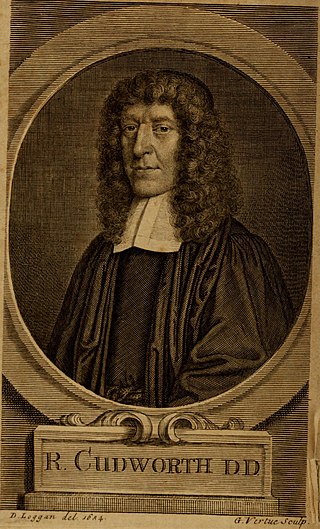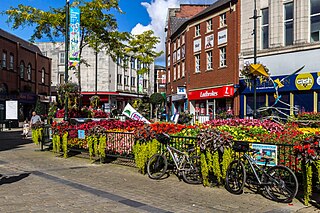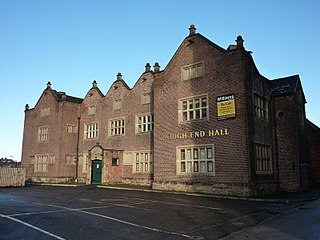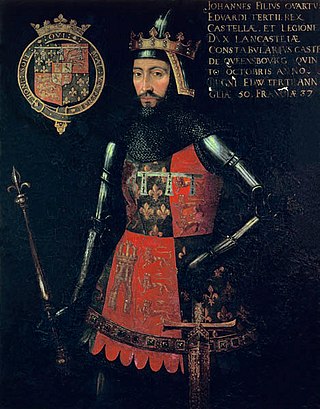
Ralph Cudworth was an English Anglican clergyman, Christian Hebraist, classicist, theologian and philosopher, and a leading figure among the Cambridge Platonists who became 11th Regius Professor of Hebrew (1645–88), 26th Master of Clare Hall (1645–54), and 14th Master of Christ's College (1654–88). A leading opponent of Hobbes's political and philosophical views, his magnum opus was his The True Intellectual System of the Universe (1678).

Oldham is a town in Greater Manchester, England. It lies amongst the Pennines on elevated ground between the rivers Irk and Medlock, 5 miles (8.0 km) southeast of Rochdale, and 7 miles (11.3 km) northeast of Manchester. It is the administrative centre of the Metropolitan Borough of Oldham, which had a population of 237,110 in 2019.

Chadderton is a town in the Metropolitan Borough of Oldham, Greater Manchester, England, on the River Irk and Rochdale Canal. It is located in the foothills of the Pennines, 1 mile (1.6 km) west of Oldham, 5 miles (8.0 km) south of Rochdale and 6 miles (9.7 km) north-east of Manchester.

Hollingworth is a village in the Metropolitan Borough of Tameside, in Greater Manchester, England. It is about 11 miles (19 km) east of Manchester on the Derbyshire border near Glossop. Historically part of Cheshire, it gave its name to a family who owned much of the surrounding area from before the time of the Norman conquest.
Glodwick is an area of Oldham, Greater Manchester, England. It is south-east of Oldham town centre.

Lancashire is a county of England, in the northwest of the country. The county did not exist in 1086, for the Domesday Book, and was apparently first created in 1182, making it one of the youngest of the traditional counties.

Slaidburn is a village and civil parish within the Ribble Valley district of Lancashire, England. The parish covers just over 5,000 acres of the Forest of Bowland.

Werneth is an area of Oldham, Greater Manchester, England. The population at the 2011 census was 12,348. It is 1 mile (1.6 km) west-southwest of Oldham's commercial centre and one of its most ancient localities. It is contiguous with Westwood, Hollinwood, Hollins and Chadderton. Werneth includes Freehold between Werneth Park and Oldham's border with Chadderton at Block Lane.

Hough End Hall is a historic house now in Chorlton-cum-Hardy, Manchester, England. It was built in 1596 during the reign of Queen Elizabeth I by Sir Nicholas Mosley, when he became Lord of the Manor of Manchester and of the dependent Manor of Withington. The Mosleys were an influential Mancunian family from the 16th century onwards, and prominent in the affairs of the Manchester district for two and a half centuries.
The Stotts were a family of architects from Oldham, North West England, of Scottish descent who specialised in the design of cotton mills. James Stott was the father, Joseph and his elder brother Abraham Stott had rival practices, and in later years did not communicate. Their children continue their practices.

The High Sheriff of Lancashire is an ancient office, now largely ceremonial, granted to Lancashire, a county in North West England. High Shrievalties are the oldest secular titles under the Crown, in England and Wales. The High Sheriff of Lancashire is the representative of the monarch in the county, and is the "Keeper of The King's Peace" in the county, executing judgements of the High Court through an Under Sheriff.

The history of Oldham is one of dramatic change, from obscure Pennine hamlet to preeminent mill town and textile processing capital of the world. Oldham's industrial history includes hatting, coal mining, structural engineering, mechanical engineering, textile machinery manufacture and cotton spinning - for which the town is most noted.
Dame Sarah Anne Lees of Werneth Park, Oldham, was an English Liberal politician, activist, and philanthropist who was the first female councillor elected in Lancashire (1907–19) and the first female Mayor of Oldham (1910–11), only the second woman in England to hold such a position.

St Maxentius' Church is in Bradshaw, Bolton, Greater Manchester, England. It is an active Anglican parish church in the deanery of Walmsley, the archdeaconry of Bolton and the diocese of Manchester. Its benefice is united with those of five other local churches. Standing separately from the church is the tower of an earlier church. The present church is dedicated to Saint Maxentius, an obscure French saint, and is the only church in England with this dedication.

Oldham Metropolitan Borough Council, also known as Oldham Council, is the local authority of the Metropolitan Borough of Oldham in Greater Manchester, England. It is a metropolitan borough council and provides the majority of local government services in the borough. The council has been a member of the Greater Manchester Combined Authority since 2011.

Middleton Junction is an industrial and residential district lying on the common border of Middleton in the Metropolitan Borough of Rochdale and Chadderton in the Metropolitan Borough of Oldham, Greater Manchester.
John Frederick Lees was a British landowner and Liberal Conservative politician who represented Oldham in the House of Commons of the United Kingdom as a Member of Parliament from 1835 to 1837.
Ralph Cudworth was a scholar and conforming Anglican clergyman of puritan sympathy who is best known as the father of the philosopher Ralph Cudworth (1617–88), and the Plymouth Colony emigrant, soldier, and colonist, General James Cudworth (1612–82).
Werneth Park is a public park in Oldham, Greater Manchester, England, including a Grade II* listed community centre, music rooms, Dame Sarah Lees Memorial, gardens and sports facilities.
Cudworth is an English locational surname, of Old English origin, deriving from the locations of Cudworth in Yorkshire, Somerset or Surrey. although the Yorkshire location is the most likely.















